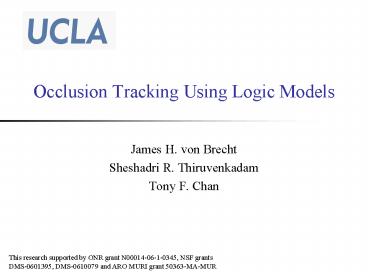Occlusion Tracking Using Logic Models - PowerPoint PPT Presentation
1 / 14
Title:
Occlusion Tracking Using Logic Models
Description:
This research supported by ONR grant N00014 ... Affine motion. Approach: ... can be represented as an affine transformation of the shape prior modulo occlusion. ... – PowerPoint PPT presentation
Number of Views:39
Avg rating:3.0/5.0
Title: Occlusion Tracking Using Logic Models
1
Occlusion Tracking Using Logic Models
- James H. von Brecht
- Sheshadri R. Thiruvenkadam
- Tony F. Chan
This research supported by ONR grant
N00014-06-1-0345, NSF grants DMS-0601395,
DMS-0610079 and ARO MURI grant 50363-MA-MUR
2
Tracking Under Occlusions
- Objective Video tracking of objects under
occlusions and in complex backgrounds. - Assumptions
- Availability of prior shape.
- Affine motion.
- Approach
- Use prior shape information to locate and
segment object in current frame. - Incorporate shape prior intelligently using Logic
Models
3
Tracking Under Occlusions
- When occlusions are present, image data alone can
be unreliable, and is not sufficient to detect
the object of interest. - Must incorporate some prior knowledge about the
object for successful detection when occluded. - Prior Shape
- Motion Model
- Other energy minimization approaches incorporate
prior shape as an additive constraint. - Energy IMAGE SHAPE
- Additive constraints depend upon a notion of
scale, and hence are sensitive to undesirable
local minima issues. - Using Logic Models, we couple prior shape and
image data into one energy term - Energy IMAGE/SHAPE
SIP 2007
4
Logic Models
- Given two (registered) images, we can combine the
objects in each image according to a pre-selected
logical operation (AND/OR) into one segmentation
for both images
5
Segmentation Energy
- Segmentation is achieved by minimizing a
functional of the familiar form - The image terms and vary depending
upon the choice of Logic Model, and combine the
images and in a particular way in order
to achieve the desired segmentation. - is the Heaviside function, is the level-set
function used for segmentation, and is some
regularization term. For example, - Note that we must minimize a different energy if
our choice of logic model were to change (must
automate this choice for tracking).
6
Segmentation Energy
- The image terms extend the Chan-Vese segmentation
energy to handle multiple images - Depending upon the desired Logic Model, we have
SIP 2007
7
Incorporating Prior Shape
- By applying the correct Logic Model, we can
utilize available prior shape information to
locate and segment an occluded object. - Shape prior is represented as a binary image
i.e. - Correct logical combination depends upon the
similarity of the objects intensity and the
occlusions intensity. - Similar gt AND
- Dissimilar gt OR
Original Image/ Shape Prior
AND Model
OR Model
8
Incorporating Prior Shape
- Knowing the correct Logic Model to apply allows
us to avoid segmentation local minima which can
occur by simply introducing shape additively - Additionally, using the opposite Logic Model (OR
in the above example) by mistake results in an
incorrect segmentation must determine correct
model automatically!
AND Model
Chan-Vese Shape
OR Model
9
Automatic Use of Logic Models
- Given two segmentation results, from OR and
from AND, the correct model will deviate
least from the shape prior, and thus minimizes
the quantity - To enforce this in practice,we first compute
and , check the above term for each, then
choose the minimizer as the segmentation result.
10
Tracking With Logic Models
- We assume the object in the current frame of
a video sequence can be represented as an affine
transformation of the shape prior modulo
occlusion. - Thus, we wish to minimize our segmentation energy
both with respect to the active contour and
the transformation -
11
Tracking with Logic Models
- General algorithm (sequential segmentation)-
- Use the result from the previous
frame to generate an initial guess for the
current frame . - Compute via gradient descent on the AND
energy with as initial data. - Compute via gradient descent on the OR
energy with as initial data. - Check for each and
select as whichever gives a minimum.
12
Limitations and Future Work
- Naïve approach to tracking
- No explicit motion model.
- Can be sensitive to registration local minima
when image quality is poor. - Sequential segmentation can fail if object motion
is too great between frames. - Cannot handle total occlusions.
- Computationally expensive.
- Future work
- Incorporate logical framework into more
sophisticated Bayesian-based tracking techniques,
e.g. Particle Filtering, Kalman Filtering. - Goal robust, real-time tracking.
13
Sample Results
14
Sample Results































